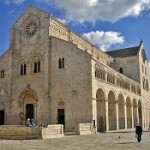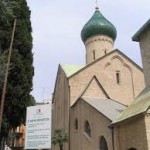![]() In religion, as in other fields of life, there are theory and practice. The theory is doctrine, our beliefs about God, beginning with the two fundamental doctrines, the Trinity (God is three persons and one substance) and the Incarnation (the belief that Jesus Christ is fully man and fully God). Of course there is much more to say about God, about humanity, the world and so on. The practice is the practical deeds of love and charity to those in need and our willingness to forgive others.
In religion, as in other fields of life, there are theory and practice. The theory is doctrine, our beliefs about God, beginning with the two fundamental doctrines, the Trinity (God is three persons and one substance) and the Incarnation (the belief that Jesus Christ is fully man and fully God). Of course there is much more to say about God, about humanity, the world and so on. The practice is the practical deeds of love and charity to those in need and our willingness to forgive others.
Sometimes people separate theory and practice in an unbalanced way, but the saints have always combined Orthodoxy (theory) and Orthopraxis (practice) together and this is true of the saint we commemorate today.
St. Nicholas was born in Patara (now in Turkey) to devout parents. He was zealous for God from childhood, observing the fasts of the church from an early age. His parents died when the saint was a child and he was raised by his Uncle Nicholas, who was bishop of Patara. Bishop Nicholas ordained his nephew a priest. In the years 315-318, St. Nicholas lived as a monk in the Holy Land before returning to Asia Minor, to Myra, where he as consecrated bishop in 317.
Around this time a priest named Arius in Alexandria Egypt was teaching that Jesus Christ was not God. He said that Jesus was the most perfect creature that was ever made but he was not God. This teaching became an intense topic of discussion, so much so that it disturbed the peace of the Roman Empire. In response to this the Emperor Constantine called a meeting of bishops in a place called Nicea to settle this issue. At this council Arius explained his point of view, which so upset St. Nicholas that he actually slapped Arius in the face. For this act the other bishops were going to depose him from his rank, but Jesus Christ himself and his Mother appeared to the bishops in their dreams and told them St. Nicholas should not be deposed. Now of course, the church does not approve of striking people, but this shows how zealous St.
Nicholas was for Orthodoxy. St. Nicholas (and the other council fathers) knew that if Jesus Christ were not God he could not destroy the power of sin, death and the devil.
St. Nicholas defended the divinity of Christ, not as an abstract issue, but as a matter of concern for his flock. As we shall see in a moment, St. Nicholas cared deeply about the material needs of his people, but also cared for their spiritual needs.
But of course, St. Nicholas was also famous for his acts of charity, the most famous of which is the following.
There as a man who had three daughters but he did not have enough for the daughters’ owries so they could get married. This meant they might end up as prostitutes. St. Nicholas, heaving this story, went to this man’s house at night and threw three purses withy gold through the window to help these young women. Another version of the story has St. Nicholas throwing the purses down the chimney and they fall into the daughters’ stockings which were hanging on the fireplace to dry. Here we can clearly see St. Nicholas as the forerunner of Santa Claus.
After his death, St. Nicholas relics remained in Myra. However, in the chaos caused by the rise of the military threat of the Seljuk Turks in 1087 the relics were taken to Bari, Italy where they remain today. At his shrine in Bari, both Catholics and Orthodox have a church. Every year on his feast day the relics of St. Nicholas exude a fragrant liquid known as myrrh.
In 2009 the Turkish government asked Italy to return the relics to Turkey. So we see that St. Nicholas is an example of zeal for Orthodoxy, but at the same time an example of zeal in helping others and is venerated beyond the borders of the Orthodox Church. In modern society St. Nicholas has been turned into Santa Claus but his origins are in the church.
Having seen that St. Nicholas was the prototype of Santa Claus, let us look at some of the St. Nicholas/Santa Claus customs around the world.
IRELAND – According to local Irish legend, Saint Nicholas is buried in County Kilkenny, Ireland. The grave is said to be in the ruined Church of St Nicholas in a medieval village, Newtown Jerpoint. Though the church dates from 1170, the grave slab appears to be from the 1300s. The tale tells of a band of Irish-Norman knights from Jerpoint, traveling to the Holy Land to take part in the Crusades. On retreat, as they headed home to Ireland, it is said they seized St Nicholas’ remains, bringing them back to Kilkenny, where the bones were buried.
RUSSIA – Vladimir the Great brought stories of St. Nicholas to Russia in the 11th century. There Nicholas became greatly revered as the protector of the weak, the oppressed and the poor. Russian merchants revering St. Nicholas the Wonderworker as the patron of all who travel on land or sea, dedicated churches to him. As patron of farming and cattle and master of water, St. Nicholas the Wonderworker is present in many sayings. For example, “The winter Nicholas will bring the horse to the stable. The spring Nicholas will feed the horse.”
ITALY – The San Nicola festival commemorates the 1087 arrival of St. Nicholas’ remains in Bari,  Italy. When Turks conquered Asia Minor, many Christians were afraid they would no longer be permitted to visit the popular site of Nicholas’ tomb in Myra. So Italian sailors spirited the away to Bari where a huge basilica was built in honor of the saint. At the festival every May, Nicola’s statue is taken out to sea for a day. T
Italy. When Turks conquered Asia Minor, many Christians were afraid they would no longer be permitted to visit the popular site of Nicholas’ tomb in Myra. So Italian sailors spirited the away to Bari where a huge basilica was built in honor of the saint. At the festival every May, Nicola’s statue is taken out to sea for a day. T housands welcome it back to Bari with a lighted procession winding from the harbor to a public square. On St. Nicholas Eve in December, children put a plate on the table with a letter asking for gifts and promising to be good in the coming year. During the night, San Nicola fills most of the requests and piles the plates with chocolates, candies, and other good things.
housands welcome it back to Bari with a lighted procession winding from the harbor to a public square. On St. Nicholas Eve in December, children put a plate on the table with a letter asking for gifts and promising to be good in the coming year. During the night, San Nicola fills most of the requests and piles the plates with chocolates, candies, and other good things.
AUSTRIA – St. Nicholas, the special children’s saint, is honored throughout Austria. It is said that God rewarded Nicholas’ generosity by allowing him to return to earth each year to bring gifts to all the good children. He comes dressed as a bishop with flowing robes and a mitre, carrying a big book and a bishop’s staff. During the year angels, who sometimes come with him, write children’s good and bad deeds in this book. In Austria a strange and frightening creature, Krampus , is usually with St. Nicholas. This devil figure, often in chains, is dressed in fur with a scary mask and a long red tongue. Krampus carries a wooden stick to threaten children but St. Nicholas never lets Krampus harm anyone. Children leave shoes for St. Nicholas on the windowsill or outside their bedroom doors. In the morning they find them with oranges, apples, nuts, sweets, and small toys.
ARUBA – In a Caribbean celebration with origins in the Netherlands, the Dutch Sinterklaas sails into harbor from Spain in mid-November, with his white horse and an entourage of helpers. A parade follows with the saint and his helpers throwing Pepernoten (spice cookies) to the children. On St. Nicholas Eve, 5 December, children put a bucket of water and a shoe filled with hay or a carrot outside for the saint’s big white horse. If they have been good, the shoes will be filled with gifts by morning. If they haven’t been good, Zwarte Piet (St. Nicholas’ helpers) just might pop them into a large sack and carry them back to Spain. During the evening gifts are exchanged in the Dutch way by wrapping them in elaborate disguises and presented with a humorous poem about the recipient.
BULGARIA – Nikulden – December 6th, is a great winter festival. Bulgarians celebrate St. Nicolay as the protector of sailors and fishermen. Like Greek sailors, Bulgarians keep icons of St. Nicolay on shipboard seeking protection from storms. The autumn fishing season ends on Nikulden. The day’s catch is to be offered to the saint and a fish dish, ribnik, carp wrapped in dough or baked with rice is made, along with two special loaves of bread. After wafting incense over the food, the host raises the bread high, and breaks it in half. One half he keeps, the other is left on the table. The cross-shaped crown bone from the fish head (the krakhche) is also kept—it may be buried as a protection for the house or grandmothers used to sew it in children’s caps to protect them from evil. The food is kept out on the table all day to be shared with neighbors and other guests.
http://www.stnicholascenter.org/pages/around-the-world
St Nicholas the Wonderworker and Archbishop of Myra in Lycia
Troparion — Tone 4
You were revealed to your flock as a rule of faith, an image of humility and a teacher of abstinence; your humility exalted you; your poverty enriched you. Hierarch Father Nicholas, entreat Christ our God that our souls may be saved.
Kontakion — Tone 3
You revealed yourself, O saint, in Myra as a priest, For you fulfilled the Gospel of Christ By giving up your soul for your people, And saving the innocent from death. Therefore you are blessed as one become wise in the grace of God.
Fr. John
